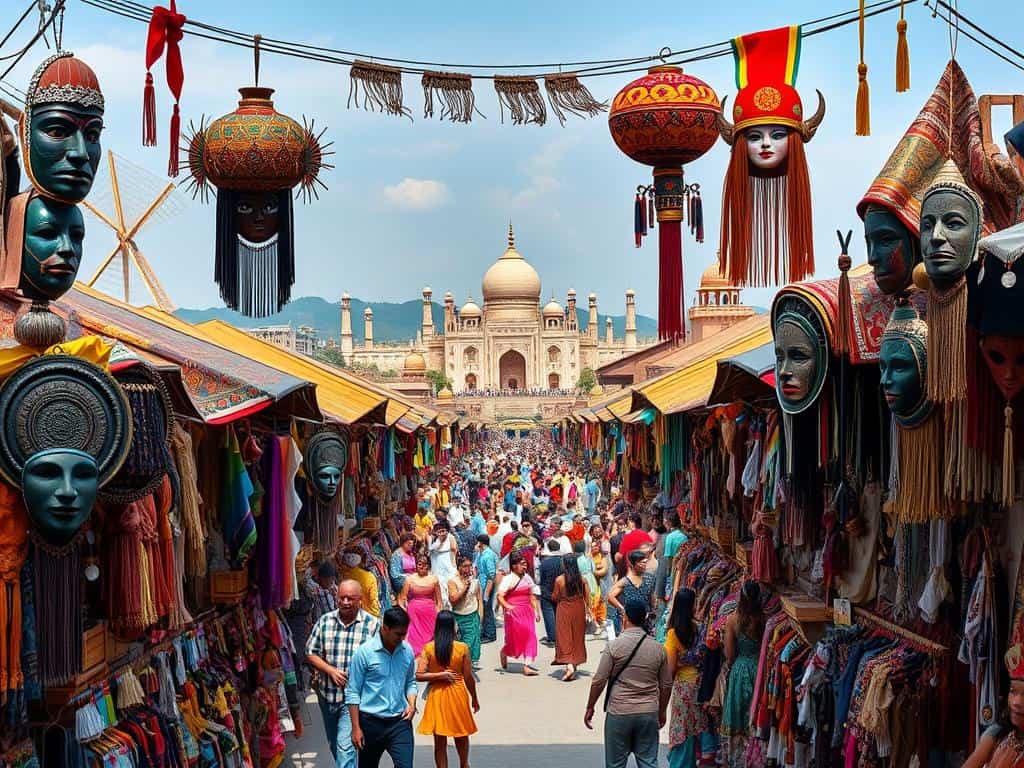While sitting at a café, I overheard a group of travelers talking. One shared about a tradition in Indonesia that celebrates life in death. It showed me how unique each culture is, with its own beliefs and practices.
In our often similar-seeming world, discovering these traditions is like finding treasure. They range from lively festivals to touching rituals, each with its own beauty. By exploring them, we can truly appreciate our world’s diverse cultures.
Key Takeaways
- Exploration of diverse global cultures enhances our understanding of humanity.
- Unique traditions are pivotal in preserving cultural identity and heritage.
- Fascinating traditions can be found in both joyous celebrations and solemn rituals.
- Every culture has practices that contribute significantly to a vibrant world.
- Recognizing and respecting these global traditions fosters unity and appreciation.
Exploring Unique Global Cultures
On my journey, I’ve learned that understanding diverse traditions is key. Each culture has its own story, influenced by history, society, and environment. These traditions showcase the bond within communities, helping to shape their identity.
Understanding the Diversity of Traditions
Different cultures show the extent of human imagination through practices that vary. From lively festivals to serious rituals, each one carries significant meaning. By engaging with these traditions, I gain a deeper appreciation for our diverse world.
Importance of Cultural Preservation
With the world getting more connected, keeping cultures alive becomes crucial. Protecting unique traditions allows future generations to learn from history. I think supporting cultural preservation enriches everyone’s life.
Intriguing Cultural Practices from Around the World
Cultural practices let us peek into how different people show beliefs and values. It captures my interest to see how traditions like those in Indonesia, the Burning Man Festival, and the Day of the Dead reveal unique human tales and bonds.
Indonesian Toraja Funeral Rites
The Toraja in Indonesia hold fascinating funeral traditions. Their ceremonies, taking several days, involve grand feasts and offerings. This shows their deep respect for those who’ve passed, underscoring the value of family and memory in their culture.
Nevada’s Burning Man Festival
The Burning Man Festival in Nevada is more than an event; it’s life-changing. It gathers thousands to explore art, express selves, and unite in creativity. A city emerges in the desert, celebrating freedom and community, highlighting how personal and shared experiences coexist.
The Day of the Dead in Mexico
In Mexico, the Day of the Dead is a lively fest that pays tribute to the deceased. Families set up altars with photos, keepsakes, and foods, welcoming spirits for a heartfelt reunion. It merges local and religious customs, capturing the essence of memory and togetherness through generations.

Fascinating Customs that Showcase Global Cultures
Customs around the world show off rich traditions. These define cultural identities. Unique beauty practices and communal rituals give insights into different peoples’ values and ways of life.
The Himba People’s Red Ocher Beauty Ritual
The Himba in Namibia use red ocher in their beauty rituals. It’s a big part of their identity. The ocher beautifies the skin and protects against the environment.
Himba women mix butterfat with red ocher for their skin and hair. This beauty practice is more than just looking good. It’s about their connection to the land and honoring their heritage.
The Ethiopian Coffee Ceremony
The Ethiopian coffee ceremony is a key social event. It involves roasting, grinding, and brewing coffee in a traditional pot. It’s about sharing and bringing people together.
This ritual makes room for talking and bonding. It shows how cultural traditions help maintain social ties.
The Maasai People’s Enkipaata Ceremony
The Enkipaata ceremony is vital for Maasai young men. It marks their step into adulthood. The community comes together, strengthening social ties.
They perform dances, songs, and rituals. It celebrates their identity. These customs unite the community and ensure their future, stressing the role of tradition and education.
Conclusion
As I wrap up my exploration of these fascinating cultural traditions, it’s clear how diverse our world is. From Indonesia’s Toraja funerals to Mexico’s Day of the Dead, every tradition shows a side of human life and feelings. These customs make me see the beauty in our differences and connect us all.
Getting to know these customs can open our minds. The beauty rituals of the Himba and Ethiopia’s coffee ceremony show how traditions can improve our lives. Through these, I’ve learned to value diversity more, enriching my understanding and respect for others.
By exploring these practices, we see the world through new eyes. I encourage you to discover and share your cultural stories. Honoring these traditions helps us all connect stronger and cherish the vast richness of human culture.



